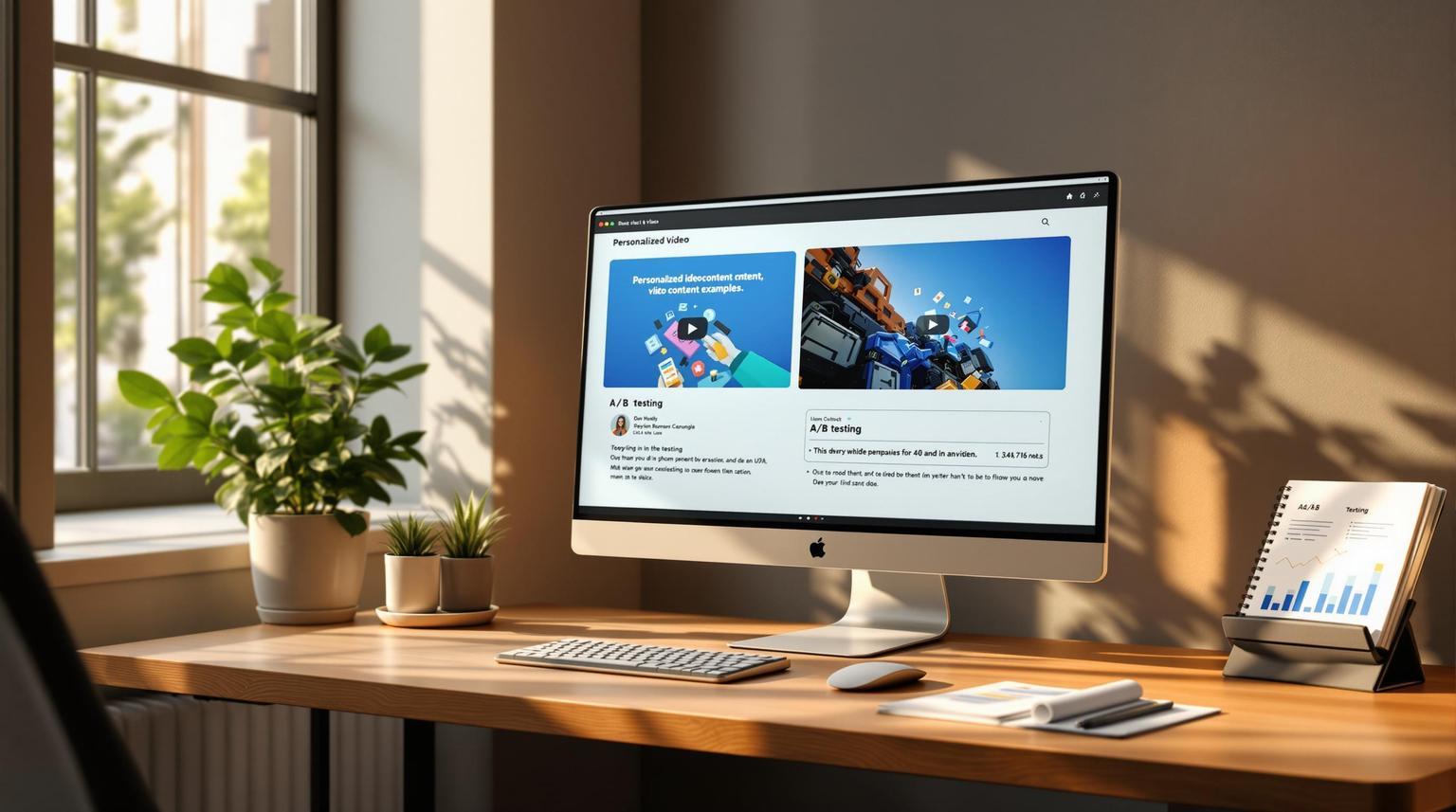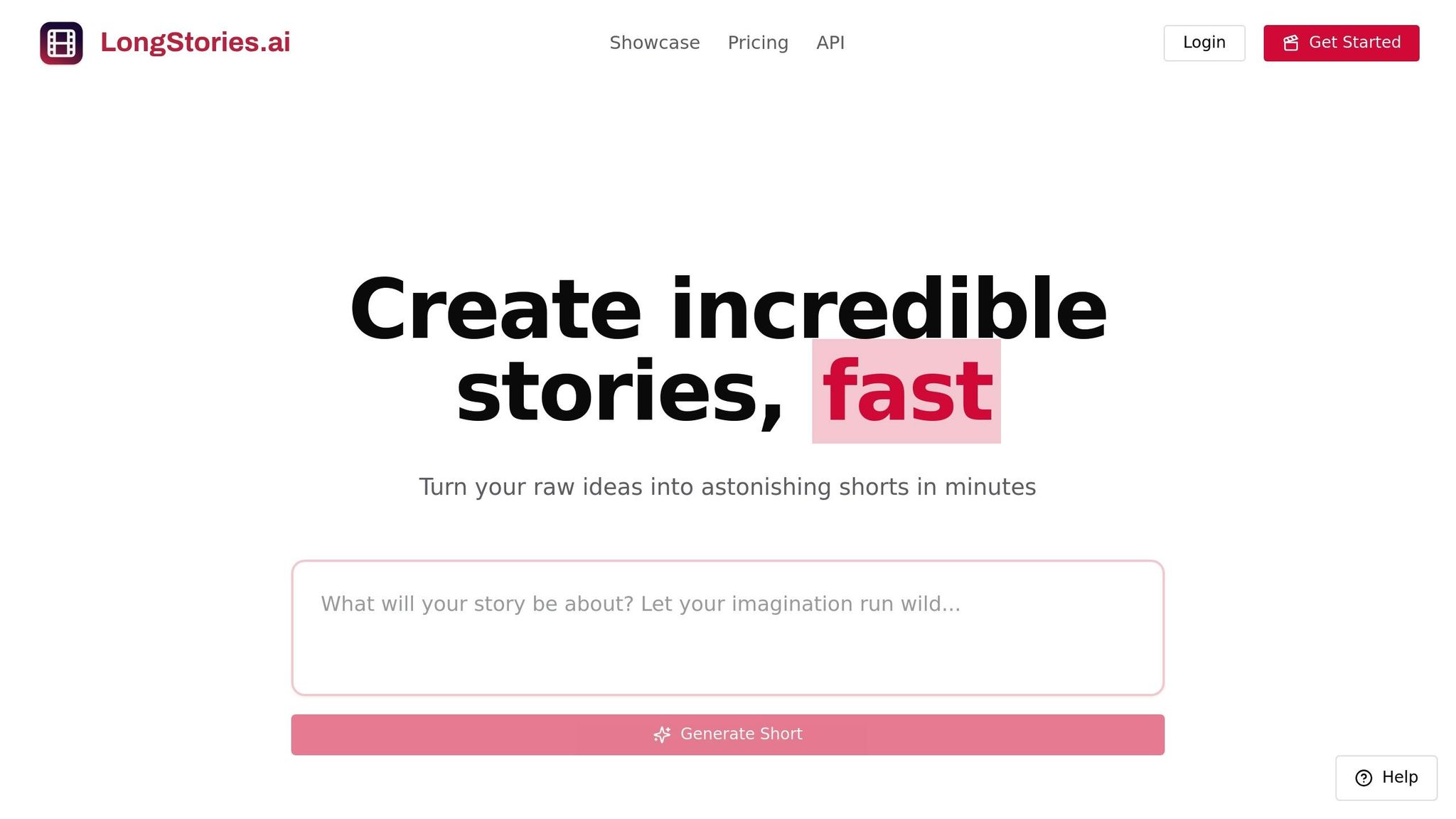
LongStories is constantly evolving as it finds its product-market fit. Features, pricing, and offerings are continuously being refined and updated. The information in this blog post reflects our understanding at the time of writing. Please always check LongStories.ai for the latest information about our products, features, and pricing, or contact us directly for the most current details.
A/B Testing for Personalized Video Content
A/B testing is a simple way to improve personalized video content by comparing two versions of a video to see which performs better. It helps marketers increase engagement, boost conversions, and make data-driven decisions. Here's what you need to know:
- Why It Matters: Personalized videos can improve click-through rates (CTR) by 200% and are preferred by 80% of consumers.
- What to Test: Focus on one element at a time, such as thumbnails, titles, introductions, CTAs, or video length.
- How to Test: Divide your audience into balanced groups, ensure at least 1,000 participants per variation, and run tests for 1–2 weeks.
- Key Metrics: Track view duration, CTR, conversion rates, and engagement metrics like comments and shares.
- Tools to Use: Platforms like LongStories.ai, Wistia, and Brightcove help create and analyze video variations.
AB Testing in Digital Marketing (Tips & Tools)
How to Plan Video A/B Tests
A well-structured video A/B test can deliver valuable insights. Here's how to plan effectively in three steps.
Define Test Goals
Start by setting specific objectives tied to measurable outcomes. For example, aim for something like: "Boost video completion rate by 15% for first-time viewers".
Key metrics to monitor:
- View duration: How long viewers stick around.
- Click-through rates: Are viewers clicking your links?
- Conversion rates: Are they taking the desired next step?
- Return viewer rate: Are they coming back for more?
Select Test Elements
To get clear results, focus on testing one variable at a time. This avoids confusion and ensures the data points to actionable insights.
Elements to consider testing:
- Thumbnails: Does a character close-up or an action shot work better?
- Titles: Which title grabs attention?
- Introductions: Does the first 10 seconds hook viewers?
- CTAs: Which call-to-action drives more engagement?
- Length: Is shorter or longer content more effective?
A great example is Netflix's A/B testing for "Stranger Things." They tested thumbnail variations - character close-ups vs. action shots - and saw a 35% jump in viewer engagement. This shows how even small tweaks can lead to big changes.
Divide Test Groups
For reliable results, your test groups must be well-balanced. Randomly assign viewers to control and test groups.
Here’s what you’ll need:
- At least 1,000 participants per variation
- 100 conversions per variation for conversion-focused tests
- A test duration of 1–2 weeks minimum
Use statistical tools to calculate the right sample size based on your current traffic and confidence level. This ensures you don’t stop the test too early or run it with insufficient data.
Running Video A/B Tests
Once you've set clear test parameters during the planning phase, it's time to bring your campaigns to life. Here's how to execute them effectively:
Make Video Versions
When crafting test variations, focus on changing just one element at a time. This ensures you can pinpoint the impact of that specific change. Keep all other aspects consistent to maintain reliable results. Tools like LongStories.ai can simplify the process, especially if you're working with multiple versions.
Key things to keep consistent:
- Same production quality across all versions
- Unique IDs for each variant
- Detailed change log to track adjustments
Launch Tests on Platforms
Tailor your test format to fit the strengths of each platform:
- YouTube: Test thumbnails or end screens
- Facebook: Run split tests for video ads
- Email campaigns: Try different thumbnail designs
- Instagram: Optimize preview frames
Take inspiration from Netflix's approach to thumbnail testing. For instance, YouTube's built-in A/B testing tool for thumbnails is particularly effective. According to Brightcove, optimized thumbnails can boost click-through rates by up to 30%.
Check Test Validity
To ensure your results are meaningful, keep an eye on statistical accuracy. Watch for factors that could skew your data, like seasonal trends or external influences. This helps maintain the integrity of your findings.
sbb-itb-94859ad
Understanding Test Results
When you run tests, it's crucial to break down the data into three main areas: engagement patterns, factors driving conversions, and any challenges in execution.
Video Test Metrics
Tracking the right metrics is key to evaluating how well personalized video content performs. For instance, one major e-commerce brand discovered that personalized product videos led to a 15% higher completion rate and a 23% boost in conversions compared to their standard video formats.
Here are some important metrics to keep an eye on:
- Completion rates and total watch time
- Engagement metrics like likes, comments, and shares
- Click-through rates (CTR) and conversions that align with your test objectives
Common Analysis Errors
Misinterpreting test data can lead to poor decisions. Here are a few common mistakes to watch out for:
- Confirmation Bias: For example, a 20% CTR increase from personalized thumbnails was later found to be influenced by an unrelated promotional event.
- Statistical Validity: Ensure your results are reliable by sticking to consistent testing conditions and controlling any external variables.
- External Factors: Seasonal trends, market shifts, or platform algorithm changes can distort your data if not accounted for.
Apply Test Findings
Turn your insights into action by following a structured approach:
- Use templated workflows, such as those offered by LongStories.ai's style agents.
- Automate personalization based on patterns in user data.
- Expand successful strategies across other campaigns.
For example, a travel company used this method and saw a 40% jump in booking conversions by leveraging data-driven personalization.
A/B Testing Tools for Video
LongStories.ai for Video Creation

LongStories.ai speeds up the process of creating video variations using AI Storytelling Agents. These agents ensure your brand's tone stays consistent while trying out different narrative styles. After generating these variations, it's essential to use analytics tools to evaluate their performance.
Video Analytics Software
Video analytics tools are indispensable for gathering actionable data during A/B tests. Some of the top platforms include:
- Wistia: Offers viewer heatmaps and engagement graphs.
- Brightcove: Provides audience insights and performance predictions.
- Vidyard: Tracks conversions, especially useful for sales teams.
For example, Wistia improved viewer retention by 27% by experimenting with intro sequences.
CRM Tools for Testing
To link video test results with customer behaviors, CRM tools can:
- Monitor engagement across different customer segments.
- Correlate video performance with purchase history or customer support interactions.
- Automate the distribution of video variants.
It's crucial to ensure that data flows smoothly between your video platform and CRM system. This setup ensures your test results accurately represent how various audience groups respond to personalized content.
Use your CRM data to shape your test hypotheses and analyze results in the context of previous customer interactions. This method lets you craft personalization strategies that resonate with real customer behavior.
Summary
A/B testing personalized video content relies on a structured, data-focused approach to achieve impactful results. Combining a clear strategy with the right tools and analytics is key.
Key elements of effective testing:
-
Planning and Goals
Define clear, measurable objectives to assess success. Focus on testing one variable at a time to ensure accurate insights. -
Implementation
Ensure statistical validity by using appropriate sample sizes. Use specialized platforms to track engagement metrics and analyze viewer behavior in detail. -
Analysis and Iteration
Apply test results to refine workflows and improve systematically. For instance, a travel company achieved a 40% increase in booking conversions by using data-driven personalization.
Common pitfalls to avoid:
- Using sample sizes that are too small
- Drawing conclusions too early
- Overlooking external factors
- Focusing too much on vanity metrics
The role of technology:
As highlighted in the tools section, advanced platforms streamline the testing process with features like automated workflows and integrated analytics. This allows teams to prioritize strategic decisions while minimizing technical hurdles.
These steps provide a strong foundation for tackling questions addressed in the FAQs.
FAQs
How do you measure the effectiveness of personalization?
To evaluate how well personalization is working, tie your test metrics directly to the objectives you set in your A/B test plan (refer to the 'Define Test Goals' section).
Here are key metrics to track:
-
Engagement Metrics
These help you understand how viewers interact with your content:- Watch time
- Completion rate
- Interaction rate
-
Conversion Metrics
These show how personalization drives actions:- Click-through rate (CTR)
- Conversion rate
-
Business Impact Metrics
These measure the broader impact on your organization:- Average order value
- Customer lifetime value
- Retention rate
- Net promoter score
For example, Vidyard client RStudio saw a 720% increase in engagement by using personalized thumbnails.
To get a full picture of effectiveness, focus on these three areas:
- Use engagement metrics to assess how relevant your content is to viewers.
- Rely on conversion metrics to understand the direct business impact.
- Gather viewer feedback to complement the numbers and gain deeper insights.
